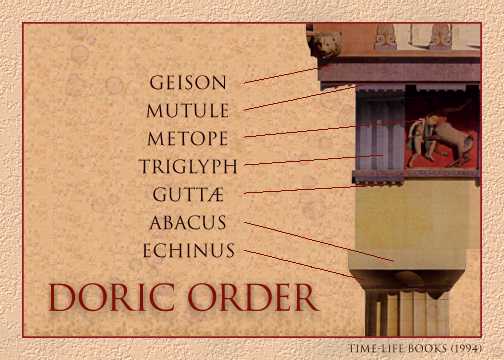

"It was wine also that drove the Centaur, famous Eurytion,
distracted in the palace of great-hearted Peirithoös
when he visited the Lapiths. His brain went wild with drinking,
and in his fury he did much harm in the house of Peirithoös....
Since his time there has been a feud between men and Centaurs,
and he was the first who found his own evil in heavy drink."Homer, The Odyssey
Invited to the wedding of Peirithoös, king of the Lapiths, Eurytion, drunk with wine, tried to rape Hippodameia, the bride. It was the ensuing battle between the Lapiths and centaurs, symbolizing the clash between civilization and barbarism, that is represented in the carved marble metopes of the Parthenon frieze.
Vitruvius explains that the ornamentation of the Doric order, its metopes and triglyphs, mutules and guttae, derived from the original wooden construction of temples. "Artists in building temples of stone and marble imitated those arrangements in their sculptures, believing that they must follow those inventions." Just as carpenters cut off the projecting ends of the supporting beams and concealed them with boards covered with blue wax, so the triglyphs, adorned with three vertical grooves and painted blue, were used to separate the metopes, which were painted red. The mutules, too, under the geison imitate the projecting rafters of the roof and are carved with the same downward slant that originally allowed water to drip down. The peg-like guttae represent wooden dowels.
He also discusses (IV.3.1) the problem of Doric angle contraction, in which the triglyphs, which should be centered above the columns, and the metopes, which should be square, requires either that the intercolumniation at the corners of the temple be reduced or the width of the metope increased.
Although the Corinthian order predominated in Roman architecture, the Doric order was used for colonnaded porticoes. In the Basilica Aemilia, for example, the short ends were Doric, with triglyphs separating metopes decorated with alternating bucrania (ox skulls) and paterae (shallow libation bowls).